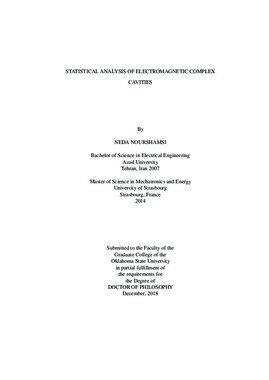| dc.contributor.advisor | Bunting, Charles F. | |
| dc.contributor.author | Nourshamsi, Neda | |
| dc.date.accessioned | 2019-07-19T14:33:30Z | |
| dc.date.available | 2019-07-19T14:33:30Z | |
| dc.date.issued | 2018-12-01 | |
| dc.identifier.uri | https://hdl.handle.net/11244/320980 | |
| dc.description.abstract | In the last decades, statistical modeling of the maximum electromagnetic (EM) field has been calculated by applying extreme order statistics and the central limit theorem. However, this method only works in the over-moded regime when the parent distribution is known. In this dissertation, the Generalized Extreme Value (GEV) distribution is introduced as an alternative statistical methodology to model the maximum field level directly in different environments such as under-moded regime or a not well-stirred environment. The distribution can converge to three different asymptotic distributions which have different tails (an upper bounded or a fat tail). In order to validate the GEV distribution, mechanical stirring is used inside the reverberation chamber and the equipment under test (EUT) box. The samples from the external stirring follows a Rayleigh distribution. However, locating a small tuner inside the cavity ("internal stirring") generates a non-Rayleigh distribution. The GEV distribution is applied through samples from internal stirring in both under-moded and over-moded regimes. A maximum likelihood estimator is used to compute the parameters of the GEV distribution. The good agreement between parametric and non-parametric (empirical) samples is achieved which is of interest in the study complex EM cavities. Additionally, the effects of varying the shape parameter of the GEV distribution on the uniformity inside the reverberation chamber are presented. The typical uncertainties inherent inside a nested chamber are also assessed, which are required for statistical modeling. Finally, the GEV distribution has been used to model the maximum field level, while the quality factor of the EUT box has been decreased by locating absorbing material inside the box. This is typically representative of locating electronic devices inside the EUT box. | |
| dc.description.abstract | As an additional contribution, we introduce multi-layers perceptron (MLP) as a function approximator to estimate the dimension of materials to have a specific quality factor inside a small cavity. In other words, instead of using random number and dimension of absorbing material, we propose using a neural network to interact the process. A committee of networks and Monte Carlo cross validation are used to improve the performance of the network. | |
| dc.format | application/pdf | |
| dc.language | en_US | |
| dc.rights | Copyright is held by the author who has granted the Oklahoma State University Library the non-exclusive right to share this material in its institutional repository. Contact Digital Library Services at lib-dls@okstate.edu or 405-744-9161 for the permission policy on the use, reproduction or distribution of this material. | |
| dc.title | Statistical Analysis of Electromagnetic Complex Cavities | |
| dc.contributor.committeeMember | Scheets, George | |
| dc.contributor.committeeMember | West, James C. | |
| dc.contributor.committeeMember | Rosenberger, Albert Thomas | |
| osu.filename | Nourshamsi_okstate_0664D_15959.pdf | |
| osu.accesstype | Open Access | |
| dc.description.department | Electrical Engineering | |
| dc.type.genre | Dissertation | |
| dc.type.material | Text | |
